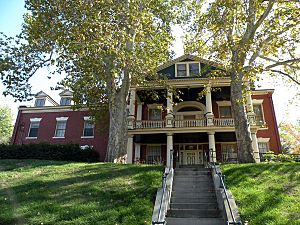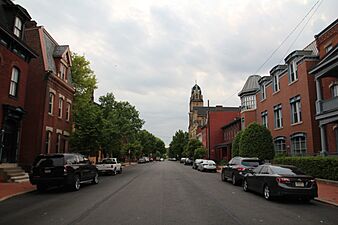Manchester (Pittsburgh) facts for kids
Quick facts for kids
Manchester
|
|
|---|---|
|
Neighborhood
|
|

Liverpool Street in Manchester
|
|

Location of Manchester in Pittsburgh
|
|
| Country | |
| State | |
| City | |
| Area | |
| • Total | 0.72 km2 (0.279 sq mi) |
| Population
(2010)
|
|
| • Total | 2,130 |
| • Density | 2,948/km2 (7,634/sq mi) |
|
Manchester Historic District
|
|
| Lua error in Module:Location_map at line 420: attempt to index field 'wikibase' (a nil value). | |
| Area | 51.6 acres (20.9 ha). Irregular pattern contained with Faulsey, Chateau, Franklin, and Bidwell Streets. |
| Architectural style | Late Victorian |
| NRHP reference No. | 75001611 |
| Significant dates | |
| Added to NRHP | September 18, 1975 |
Manchester is a cool neighborhood located on the North Side of Pittsburgh, Pennsylvania. It's a part of the city that has a lot of history. The neighborhood is looked after by the District 6 representative on the Pittsburgh City Council.
Manchester is also home to fire and police services. Firefighters from PBF Battalion 1 & 37 Engine are here. Police from PBP Zone 1 keep the area safe. The Bureau of EMS Medic 4 also serves the community.
A special part of Manchester is its Historic District. This area helps protect many old buildings. There are 609 buildings in this district. It covers about 51.6 acres. This historic district was added to the National Register of Historic Places in 1975. Manchester uses the ZIP code 15233.
Contents
A Look Back: Manchester's History
Manchester started as a small village. It was built along the river. The village helped nearby farms by providing supplies. On November 2, 1843, Manchester officially became a borough. This happened because of a law passed in Pennsylvania.
By 1868, Manchester had a busy dock. This dock needed repairs. In 1867, a new law allowed Allegheny City to take over Manchester. This meant Manchester became part of Allegheny City. It also included parts of nearby townships.
Manchester was a ward of Allegheny City until 1907. After that, it became a neighborhood of Pittsburgh. Even today, its original borders are well-known.
Exploring Manchester: Location and Features
The Manchester Historic District is very special. It's the largest historic district in Pittsburgh. It's protected under the National Register of Historic Places. This is because it has many beautiful houses. These homes were built in the early 1800s. They show the Late Victorian style.
Manchester is known for being very convenient. It's easy to walk around the neighborhood. You can also easily get to public transportation. Major roads are also close by. This makes it simple to get to other parts of Pittsburgh.
The Three Rivers Heritage Trail System runs through Manchester. This trail is great for walking or biking. It offers nice views along the river.
Who Lives Here? Manchester's Community
Manchester is mostly a place where people live. It has many homes and apartments. In 2010, about 2,130 people lived in Manchester.
A report from the University Center for Social and Urban Research shared some facts. It said that about 46.3% of homes were families. The other 55.7% were non-family households. This means many different types of people call Manchester home.
Learning in Manchester
Public schools in Manchester are managed by Pittsburgh Public Schools. This school district helps provide education for children in the neighborhood.
Neighbors of Manchester
Manchester is surrounded by several other Pittsburgh neighborhoods:
- Allegheny West
- California-Kirkbride
- Central Northside
- Chateau
- Marshall-Shadeland
Manchester in Pictures
-
Anderson Manor, built around 1830, on Liverpool Street.
-
Conroy Junior High School, built in 1936, at Page and Fulton Streets.
Famous Faces from Manchester
- Sue Kerr








